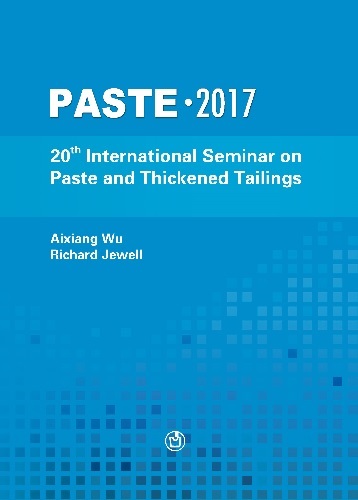Thixotropic behavior of paste

|
Authors: Wu, AX; Cheng, H; Yang, Y |
DOI https://doi.org/10.36487/ACG_rep/1752_08_Wu
Cite As:
Wu, AX, Cheng, H & Yang, Y 2017, 'Thixotropic behavior of paste', in A Wu & R Jewell (eds), Paste 2017: Proceedings of the 20th International Seminar on Paste and Thickened Tailings, University of Science and Technology Beijing, Beijing, pp. 66-73, https://doi.org/10.36487/ACG_rep/1752_08_Wu
Abstract:
Structure fluid can be broken under shear and rebuilt at the static state because of its thixotropy. The thixotropic behavior of paste slurry in transportation causes a continuous decrease of yield stress and plastic viscosity with time. There is no generally accepted method to measure the thixotropy of paste materials. In this paper, the curve of rheological properties was divided into three parts based on the rheological behavior, and a number of problems were identified using the thixotropy loops measurement to characterize the thixotropy of cement paste. Stress relaxation was considered and the variation of shear stress with time under a constant shear rate was also measured, establishing a yield stress prediction model and plastic viscosity prediction model after considering aspects of paste materials. The total thixotropic time was found to have no relevance to shear rate. Due to paste thixotropy, shear flow area increased and plunger flow area decreased over time and eventually stablized. According to the difficulty level, a standard which divides transportation into different stages was first proposed.
References:
Abebe, Y. A., Lohaus, L. 2017, ‘Rheological characterization of the structural breakdown process to analyze the stability of flowable mortars under vibration’, Construction and Building Materials, vol. 131, pp. 517-525.
Assaad, J.J., Harb, J., Maalouf, Y. 2016, ‘Effect of vane configuration on yield stress measurements of cement pastes’, Journal of Non-Newtonian Fluid Mechanics, vol. 230, pp. 31-42.
Barnes, H.A., 1997, ‘Thixotropy—a review’, Journal of Non-Newtonian Fluid Mechanics, vol. 70, pp. 1-33.
Cruz, N., Peng, Y. 2016, ‘Rheology measurements for flotation slurries with high clay contents – A critical review’, Minerals Engineering, vol. 98, pp. 137.
Dullaert, K., Mewis, J. 2006, ‘A structural kinetics model for thixotropy’, Journal of Non-Newtonian Fluid Mechanics, vol. 139, pp. 21-30.
Liu, J.Z., Wang, R.K., Gao, F.Y., Zhou, J.H., Cen, K.F. 2012, ‘Rheology and thixotropic properties of slurry fuel prepared using municipal wastewater sludge and coal’. Chemical Engineering Science, vol. 76, no. 28, pp. 1-8.
Liu, Q.S., Lu, C.B., Liu, B., Lu, X.L. 2014, ‘Research on rheological behavior for cement grout considering temperature and hydration time effects’, Chinese Journal of Rock Mechanics and Engineering, vol. 33, pp. 3730‐3740.
Møller, P.C.F., Mewis, J., Bonn, D. 2006, ‘Yield stress and thixotropy: on the difficulty of measuring yield stresses in practice’, Soft Matter, vol. 2, no. 4, pp. 274-283.
Mujumdar, A., Beris, A.N., Metzner, A.B. 2002, ‘Transient phenomena in thixotropic systems’, Journal of Non-Newtonian Fluid Mechanics, vol. 102, no. 2, pp. 157-178.
Qian, Y., Kawashima, S. 2016, ‘Flow onset of fresh mortars in rheometers: Contribution of paste deflocculation and sand particle migration’, Cement and Concrete Research, vol. 90, pp. 97-103.
Roussel, N. 2006, ‘A thixotropy model for fresh fluid concretes: Theory, validation and applications’, Cement and Concrete Research, vol. 36, no. 10, pp. 1797-1806.
Roussel, N., Ovarlez, G., Garrault, S., Brumaud, C. 2012, ‘The origins of thixotropy of fresh cement pastes’, Cement and Concrete Research, vol. 42, no. 1, pp. 148–157.
Usui, H., 1995, ‘A thixotropy model for coal-water mixtures’, Journal of Non-Newtonian Fluid Mechanics, vol. 60, pp. 259-275.
Wu, D., Fall, M., Cai, S.J. 2013, ‘Coupling temperature, cement hydration and rheological behaviour of fresh cemented paste backfill’, Minerals Engineering, vol. 42, pp. 76–87.
© Copyright 2025, Australian Centre for Geomechanics (ACG), The University of Western Australia. All rights reserved.
View copyright/legal information
Please direct any queries or error reports to repository-acg@uwa.edu.au
View copyright/legal information
Please direct any queries or error reports to repository-acg@uwa.edu.au